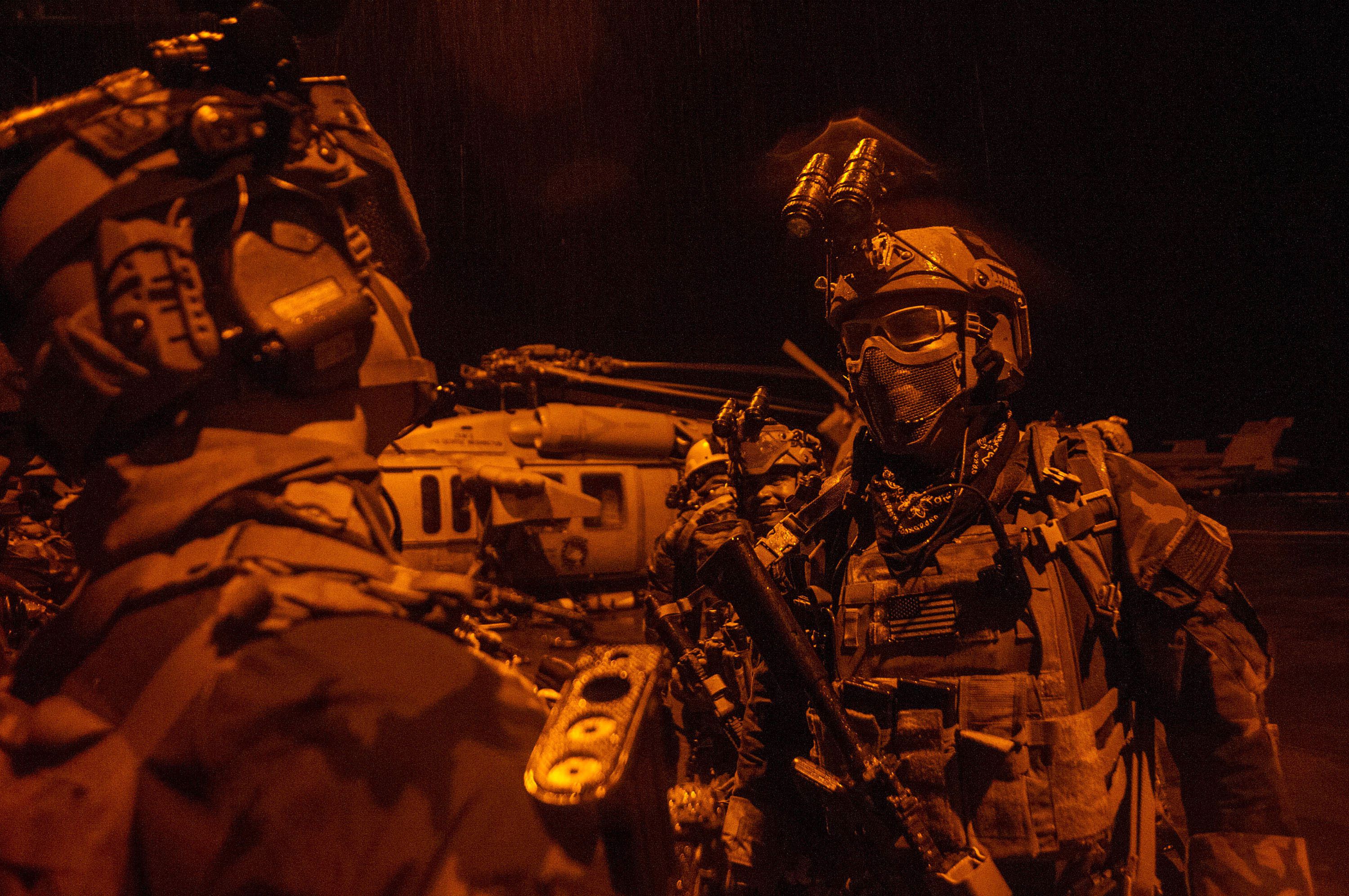Marsoc Physical Requirements - The Marine Corps hasn't had a special operations unit since World War II, but that all changed in 2003 when, in June of that year, the Marine Corps and USSOCOM formed the Marine Corps Special Operations Detachment (MCSOCOM Det 1) to investigate Unit-level Marine Corps participation in USSOCOM. Prior to this, members of the Marine Corps were against the "elite within the elite" because they considered all Marine Corps units to be elite.
MCSOCOM Det One deployed with the Marine Special Warfare Unit in support of Operation Iraqi Freedom in 2004.
Marsoc Physical Requirements

After deployment, Marine Corps contributions were studied, and in October 2005, the Secretary of Defense ordered the establishment of a Marine component of the United States Special Operations Command. It was determined that the Marine Corps would initially establish a unit of approximately 2,500 personnel to serve in the Special Operations Forces (SOF) community.
Marsoc Hi Res Stock Photography And Images
On February 24, 2006, MARSOC was activated at Camp Lejeune, N.C. MARSOC initially consisted of a small headquarters and battalion-level unit that was created to train, advise, and assist partner military nations in the conduct of the external internal defense mission.
Just a few years ago, MARSOC operators decided to choose the name "Raiders" to celebrate their lineage and the unconventional nature of their mission. The Raiders are back in shape after a long layoff.
The WWII Sea Raiders were only active for about 2 years from 1942 until they were officially disbanded in 1944. Modern MARSOC Special Operations draws its lineage from these Raider Battalions. Perhaps the best example of a Navy special operations officer was Maj. Evans F. Carlson.
Carlson was a maverick who was an intelligence officer in China, fought guerrillas in Nicaragua and spoke publicly about the plight of the Chinese. When command is given to Marine 2
Marsoc 101 Brief: All You Need To Know About Marine Corps Special Operations
Ryder B.
Every man, regardless of rank, had a say in matters and was expected to speak his mind. Their motto became the Chinese term "Gung-ho" which means "work together".
Carlson was brilliantly innovative. He implemented a major change in the organization of the Rider, where instead of the usual eight-man squad, he created a 10-man unit consisting of a squad leader and three fire teams of three men each. Each fire team had good firepower with a Thompson submachine gun, a Browning automatic rifle (BAR), and a rifleman with Garand M-1 semi-automatic rifles.

He was building an unconventional military unit that could operate as he envisioned a guerrilla unit. He instituted a training program that relied heavily on long-range movement, weapons and demolitions training, hand-to-hand combat, and physical fitness.
Week Marsoc Raider Prep Program (digital Ebook)
Today's Raiders are even better trained than their counterparts. Once a Marine has three years of service, they can volunteer for the MARSOC Raiders.
Like other special operations forces, the Marines are looking for self-starters, operators with initiative who will always seek to improve. Team players who will seek the knowledge of others to make the unit much more skilled.
For Marines designated as critical skills operators (CSOs) with MOS 0372, for 0370 officers, they must first pass Assessment and Selection (A&S). The A&S is a 21-day, mentally and physically challenging assessment. The first phase begins with the physical fitness test, or PFT, a swim and an 8-mile backpack walk. Finish off with another PFT, an abandoned boat drill, a 300 meter swim in fatigue without boots, 11 minutes of treading water and a 12 mile backpack walk in under three hours at a 45lb pace.
Marines who successfully complete A&S attend the MARSOC Individual Training Course (ITC). Much of it is like other screening and assessment courses run by other services. It places a high value on a candidate's physical fitness and ability to think when tired and under great stress.
Marine Special Operations Command (marsoc)
The ITC is a physically and mentally challenging course designed to provide MARSOC Raiders with a basic foundation of essential special operations skills. Some of the skills taught in the course include SERE, Medical, Communications, Small Unit Tactics (SMU), Amphibious Training, Special Reconnaissance, Close Combat (CQB), Urban Combat, Combat Marksmanship and Irregular Warfare.
The training and education of the Raiders does not end with the ITC. Operators will continue training after being assigned to their assigned unit. All MARSOC Marines are required to undergo ongoing language training, with designated Marines attending additional language training in an advanced linguist course.
MARSOC Marine Raiders also conduct advanced level courses in various subject areas such as Air and Static Lines Jumpmaster, Military Free Fall and HALO Jumpmaster, Sniper, Breaching and Weapons Employment, as well as many others. A total of 85 advanced training courses are available to MARSOC Raiders in their operational units.

The basic operation is a 14-man team consisting of 1 officer, 4-6 senior NCOs, 4-6 sergeants, and 2 Marines. The team is divided into one HQ element and two tactical elements. The staff element consists of a team leader captain, a team leader sergeant, an operations chief to a gunnery sergeant, and an assistant operations chief to a staff sergeant.
Us Marsoc Marine Raiders At Christmas [2500x1875]
Both tactical elements consist of 4 Marines and one Marine. The team can operate as a single unit or split into two smaller tactical units. MARSOC raiders have conducted direct action, internal external defense, special reconnaissance, counterinsurgency, security force assistance and environmental preparedness missions in more than 40 countries since their inception just over a decade ago.
They are still Marines first and Special Operators second, but with the changes making them a permanent part of the Marine Corps, they now have an MOS to stay in Special Operations for the rest of their careers. Make a better unit with superior operators with better training. Major Carlson will approve.
Revealed 1 My Three Favorite (But Obscure) War Movies 2 The Lone Survivor: The Ambush at Sawtalo Sar 3 Adam Brown: A SEAL's Life of Courage and Redemption 4 Check Out This Ex-Delta Force Operator's Charge to Take Down Human Traffickers 5 United Kingdom to Send Apache to Ukraine
Adam Brown: A Seal's Life of Courage and Redemption Full list: Ticonderoga-class guided-missile cruisers to be retired in 2027. During the war in Ukraine
Marsoc Engages The Future
Praesidus honors the tradition of military watches. With rugged designs and classic vintage style, discover the heritage of military watches today.
USAA proudly serves millions of military members and their families with competitive rates on insurance, banking and investment services. Marine Corps Special Operations Command (MARSOC) trains, organizes, equips, and deploys organized, scalable, and responsive Marine Corps special operations forces worldwide in support of combatant commanders and other agencies.
Its creation was announced on 23 November 2005 by US Secretary of Defense Donald Rumsfeld following a meeting between USSOCOM Commanding General Brian D. Brown and Commandant of the Marine Corps General Michael Hagee on 28 of October 2005. MARSOC was officially activated on February 24, 2006 with ceremonies at Camp Lejeune, North Carolina.

The Marine Corps' potential involvement in SOCOM has been controversial since SOCOM was formed in 1986. An "elite" special operations unit of Marine Corps Marines would be a detriment to the Marine Corps as a whole. The reassessment after 9/11 and the war on terrorism, along with the new policy established by Secretary Rumsfeld and then-Commandant General James L. Jones at the Pentagon, challenged the Marine Corps to work on integration with SOCOM.
Officers Are More Successful During Raider Selection, But Marsoc Is Fielding Marines At A Steady Rate
The establishment of MARSOC represented the most significant step toward that goal, and followed the establishment of MCSOCOM Detachment One (DET1), a small Marine Corps detachment formed as a pilot program to test the integration of the Marine Corps into SOCOM. It was composed mostly of Reconnaissance Marines from the 1st and 2nd Force Reconnaissance Companies, along with other handpicked support men, and served with the Navy SEALs under Naval Special Forces Group 1. Detachment 1 conducted numerous special operations in Iraq along with theirs. brothers of the services brothers of special operations. SOCOM conducted a study of the unit's deployment, which clearly indicates success and strong performance. Detachment 1 was disbanded in 2006 shortly after the creation of MARSOC.
Selecting the right personnel begins with a rigorous selection process designed to identify the right Marines for the right staff at MARSOC. Operating spaces
They are open to men only. Only those Marines who wish to serve as special operators, as opposed to support, must attend Assessment and Selection (A&S); however, all Marines are screened to ensure that Marines joining MARSOC meet the requirements established by the command. The selection is made in 3 stages: selection of records,
Marsoc officer requirements, requirements to join marsoc, marsoc pt requirements, marsoc vision requirements, marsoc fitness requirements, marsoc requirements physical, marsoc raiders requirements, marsoc requirements, marsoc marines requirements, marsoc physical training, marine corps marsoc requirements, usmc marsoc requirements
0 Comments